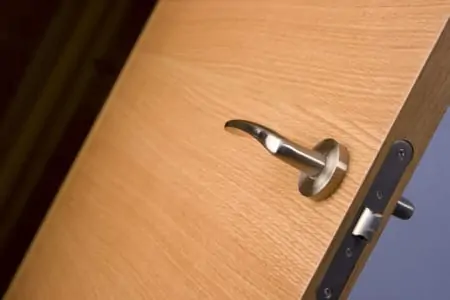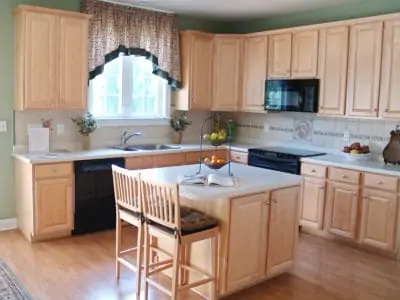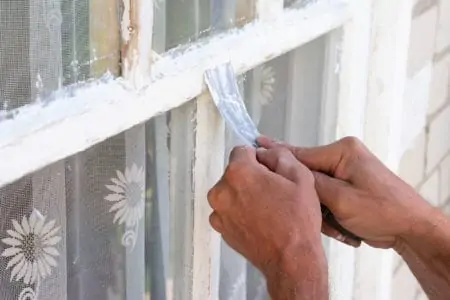Not all doors have locks, especially internal ones, so how do you get privacy? Sometimes you need a temporary solution for bedrooms, bathrooms, and other spaces within your house.
We show you how to lock a door without a lock and share several other makeshift ways to increase security.
Key Takeaways
- Use a wedge or doorstop to secure the door from opening easily.
- Place a chair beneath the door handle to create a barricade.
- Insert a sock or towel under the door to act as a makeshift wedge.
- Consider portable locks or door jammers for added security when traveling.
13 Ways to Lock a Door Without a Lock
You probably think that the best way is just to use a lock, but sometimes it is simply not possible. Maybe you are in a different location and want that added security.
There are several alternative ways to temporarily lock a door, from blocking it with a sock to creating a barricade with a chair. Here are some easy methods:
1. With a Wedge
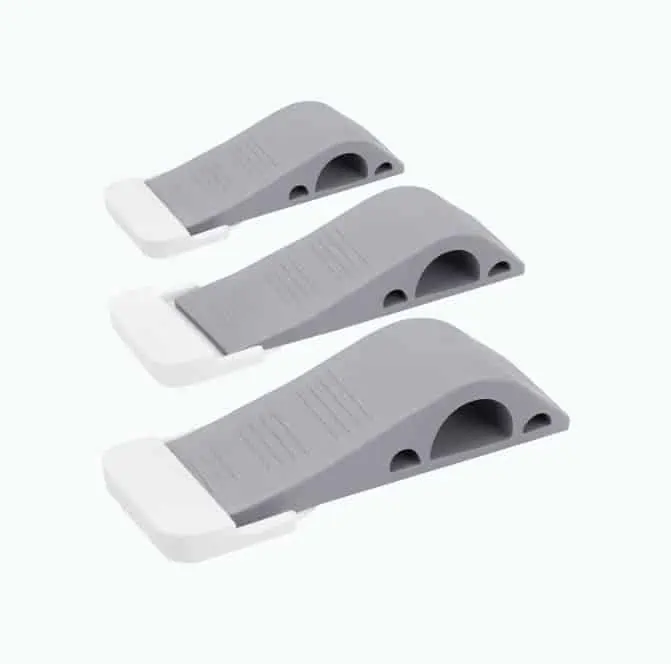
You have two options when using a wedge to secure a door: you can use a shop-bought wedge (they come in all shapes, sizes, and materials), or you could create a temporary version with cardboard.
Shop-bought wedges, like this Wundermax Door Stopper, are an excellent way to restrict access. Pop it under the door, and as pressure is applied from the other side, the door wedges further onto the stopper.
To make your own wedge, grab some scrap cardboard, tear off a strip and fold it into a wedge shape. While your doorstop works against mild pressure, it won’t withstand a sustained attack on the door.
Also, door stops are easily lost, so you may need to replace them often. Plus, a cardboard wedge is not the prettiest way to secure a door. It looks a bit make-do-and-mend.
Pros
- Easy to install and remove.
- Cheap to purchase.
- Easy to make a wedge.
- Ready available to buy.
- Secures the door.
Cons
- Won’t withstand sustained door pressure.
- Not the most aesthetically pleasing.
2. With a Fork
Okay, locking a door with a fork will require you to have a pair of pliers, a vice, and a hacksaw. So, it’s a little bit more involved than other methods. Also, don’t use your best silverware because it involves shaping and cutting the fork.
Start by bending the prongs about 0.4 inches from the end. You can use a vice or the pliers for this. Now cut the handle off just above the fork’s head using the hacksaw.
Open the door slightly and insert the prongs into the strike plate hole. Now close the door and insert the handle section through the middle prong as a locking mechanism, and the door is locked.
Take Note
Use a flat-handled fork because you need it to slide between the teeth to create the locking action.
Pros
- Secures the door well.
- Sturdier than using other methods.
- Can be reused time and again.
- Easy to deploy.
Cons
- Requires cutting up cutlery.
- Won’t withstand a door kick-in.
3. With a Chair
You’ve probably seen someone wedging a door in a movie in a desperate attempt to evade whoever is chasing them. And the good news is it actually works.
It is also the most robust way to barricade the door, as long as you get the technique right. Here’s how to do it:
Wedge the backrest of the chair under the handle. Make sure it is pressed firmly in place, and the handle cannot move. This also stops the handle on the outside of the door from operating.
If the chair doesn’t quite reach the handle, raise the chair on risers or another solid object like a book.
A chair will still wedge the door shut regardless of the type of handle, but it is far more effective with a handle rather than a doorknob.
Pros
- Sturdy method of securing the door.
- Works well with handled doors.
- Almost impossible to open the door.
Cons
- Not as reliable on doors with doorknobs.
- May need to adjust the height of the chair.
4. With a Sock
Using a sock may sound unorthodox, but it works. Stuff it under the door as a makeshift wedge. Test the door by trying to open it, but the sock should hold it firm.
Stuffing a sock under your door is not the most aesthetically pleasing technique for locking a door, but it is simple, and everyone has a sock handy (just try and ensure it’s a clean one).
This method is not the most secure way to lock a door, but it will offer some resistance against medium pressure.
Pros
- Easy to deploy.
- Easy to remove.
- Socks are readily available.
Cons
- Not aesthetically pleasing.
- Not the most secure method.
5. With a Barricade
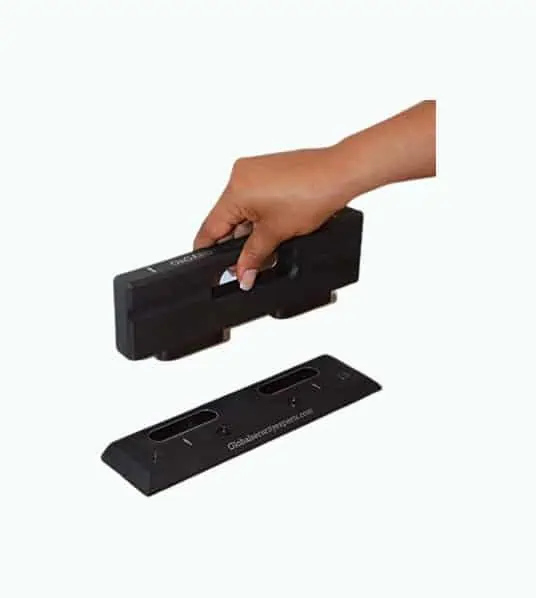
Floor barricades, like this OnGard Door Reinforcement Alternative, are an excellent way of blocking access to your door from the outside. The base plate screws to the floor just behind the door.
The top section slots into place, creating a barricade to stop the door from opening. The door still opens with the brace removed because it swings over the top of the plate.
A door barricade is a great option for modifying security within your home, but it wouldn’t work for travelers and rental properties. Screwing it into the floor causes damage.
Pros
- Super-strong defense system.
- Easy to install.
- Easy to operate.
Cons
- Damages your floor.
- Not suitable for travelers and rental properties.
- Expensive compared to other methods.
6. With a Portable Lock

Portable locks are popular because they increase security and can be used alongside your existing security measures. They are also the ideal tool to pack in your suitcase when you go traveling.
These locks were first developed with travelers in mind, giving them the ability to secure their door no matter where they were. This Addalock Portable Door Lock is an excellent example and is one of the most popular on the market.
The beauty of these devices is they require no drilling or screwing, and they can be deployed with a few simple steps. They are small and fit into your hand luggage, making them highly portable.
A portable lock has a claw that slides over the bolt on the door and a lock that holds the claw in place. It prevents the door from opening, but only on inward opening doors.
Pros
- Works with existing door security.
- Small, light, and portable.
- Designed with travelers in mind.
Cons
- Only works on inward opening doors.
7. With a Strike Plate Lock
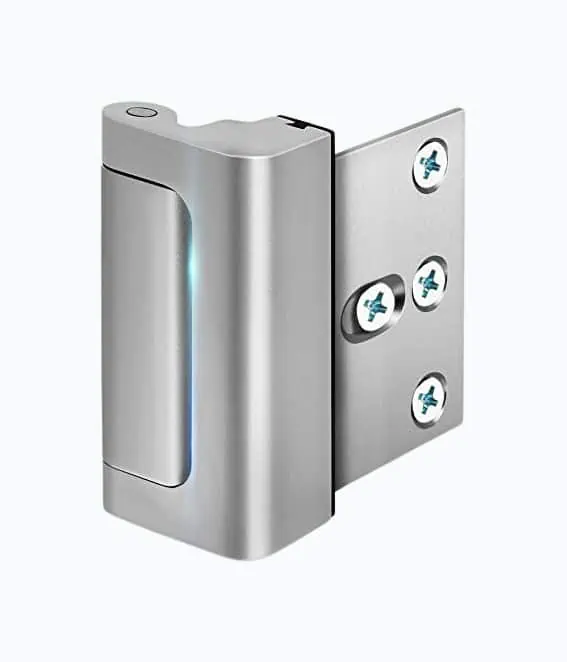
Like this EverPlus Home Security Door Lock, a strike plate lock is an excellent way of securing your doors. Strike plate locks are effective on interior and exterior doors.
They work in the same way as door chains. The plate screws to the door frame, and the barricade locks in place when the door is closed. This model can withstand 800 pounds of pressure, which means that anyone trying to kick the door open will fail.
Some strike plate locks have a latch that slips over the door handle to lock it in place. You can install it on doors without a lock or use it to enhance security with an existing lock.
A strike plate lock is unsuitable for travelers and those living in a rental property because you need to screw it into the door frame.
Pros
- Can withstand a lot of pressure.
- Enhances existing door security.
- Can be used on internal and exterior doors.
- Easy to install.
Cons
- Not suitable for travelers.
- Not ideal for rentals.
- Damages your door frame.
8. With a Security Bar
Security bars protect your exterior doors from sustained attack and extreme pressure. They work by attaching a series of brackets to your door frame or wall. A metal bar then slots into the brackets and blocks door access.
Security bars are one of the oldest methods of securing exterior doors, as long as they open inward. Outward opening doors will need a different form of security.
Security bars are excellent for securing your doors at home, but you can’t take them on your travels. Also, it screws into the door frame or wall, so be prepared to damage your woodwork.
Pros
- Withstands heavy impacts.
- Ideal for exterior doors.
- Simple to install.
- Easy to deploy.
Cons
- Damages door frames.
- Only works on inward opening doors.
- Not ideal for travelers.
9. With a Door Jammer
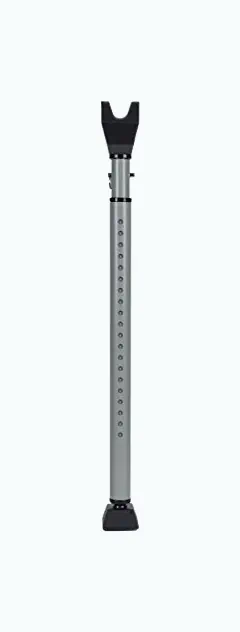
A door jammer is similar to a barricade or using the chair method. They consist of an adjustable bar with a V or U-shaped cut out at one end and a floor pad at the other. All you need to do is slide the V-shaped end under the door handle and extend the bar until the pad grips the floor.
This SABRE Security Bar is an excellent example of a door jam. It sits at a 45-degree angle, and when someone tries to open the door, the more the jammer grips. This is also a great way to secure doors in rentals because it installs without drilling.
It is portable, so if you are going traveling, pack it into your suitcase, and you can deploy it wherever you are.
However, if you are traveling light, you might consider another method because door jammers are heavy. They are also ineffectual on outward opening doors.
Pros
- Easy to install.
- Ideal for rentals.
- No drilling required.
Cons
- Not suitable for those traveling light.
- Only works on inward doors.
10. With a Towel
This is similar to the sock method in that you stuff a towel under the door to prevent people from gaining entry. And if you are traveling, you will have a towel packed in your suitcase, so it will work anywhere.
It also acts as a sound insulator because you block the gap under the door. The towel technique is okay for additional security, but compared to other methods, it won’t stop a determined intruder.
Pros
- Everyone has a towel to hand.
- Easy to deploy.
- Soundproofs as well as secures.
Cons
- Not the most secure method.
11. With a Belt
Using a belt or a piece of rope to secure a door works well, especially when you have an outward opening door. Simply attach one end of the strap to a fixed object, like a heavy piece of furniture, and the other around the handle. This method works well with both lever handles and doorknobs.
Another technique is to attach one end of the belt to a hook on the back of the door and the other looped around the lever handle. It stops the handle from moving and secures the door.
Obviously, this technique won’t work without a fixed point to anchor the belt.
Pros
- Simple to deploy.
- Easy to remove.
- Works on inward and outward doors.
Cons
- Requires a fixed anchor point.
12. With a Penny
A humble penny can keep you safe in an emergency. Arriving home and finding someone inside your property is your worst nightmare, but you can keep them there until the police arrive. Take a handful of pennies and wedge them into the gap between the door and frame.
Do it on both sides of the frame just above and below where the lock and handle are. Keep adding more pennies until you can’t squeeze any more in. The pennies force the door away from the frame, disabling the handle.
No matter how hard they try, your intruder is trapped. However, this method only really works on tight-fitting doors. If the door sits loosely in the jamb, all you will get is a rain of pennies falling as the door opens.
Pros
- Easy to deploy.
- Simple to remove.
Cons
- Not effective on loose-fitting doors.
13. Remove the Door Handle
Removing the door handle is probably the method of last resort; you would only do this in an emergency. Removing both handles makes it impossible to operate the door mechanism and secures the door. This technique secures inward and outward doors.
However, this method is time-consuming, and a determined person could activate the locking mechanism with the right tools.
Pros
- Secures inward and outward doors.
- Doesn’t require any drilling.
- Easy to deploy.
Cons
- Only suitable as an emergency measure.
- Time-consuming.
No Need For Locks
Securing your door without a lock keeps you secure in all manner of situations. All it requires is a bit of creativity and a DIY approach. Not all the methods listed are suitable for travelers and people in rented properties, but there are enough techniques to keep you safe on the road.
So, the next time you find yourself searching for a way to lock your door, worry no more, thanks to our definitive guide to locking a door without a lock.
